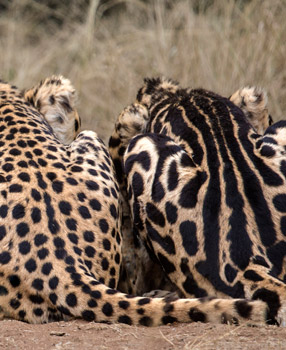SPRING 2013 CONTENTS
Home
Vital fluid
What we know about blood
Roll up your sleeve
There's still no substitute for blood
Life of blood
A guide to the cells coursing through your veins
Blood quest
The battle to protect transfusions from HIV
Against the flow
What's behind the decline in Blood transfusions?
Blood, sweat and fears
A common phobia's odd pathophysiology

DOWNLOAD PRINTABLE
ISSUE (PDF)


In brief
Spotting the evidence
Cat coats and human health
by Krista Conger
Photography by Greg Barsh
How did the cheetah get its … stripes?
”Until now, there’s been no obvious biological explanation for cheetah spots or the stripes on tigers, zebras or even the ordinary house cat,” says Stanford geneticist Greg Barsh, MD, PhD. “How do periodic patterns like stripes and spots in mammals arise? It’s kind of surprising how little is known.”
Barsh and his colleagues, including Christopher Kaelin, PhD, compared specific gene sequences among feral cats and wild and captive cheetahs. They found that the same biological mechanism is responsible for both the elegant stripes on the tabby cat and the cheetah’s normally dappled coat. Dramatic changes to the normal patterns occur when this pathway is disrupted: The resulting house cat has swirled patches of color rather than orderly stripes, and the normally spotted cheetah sports thick, dark lines down its back.
“Mutation of a single gene, called Taqpep, causes stripes to become blotches, and spots to become stripes,” says Barsh, an emeritus professor of genetics and of pediatrics at Stanford and an investigator at the HudsonAlpha Institute for Biotechnology, in Huntsville, Ala. The research was published in Science.
Taqpep encodes a protein normally found in the cell membrane, but that can also diffuse outside the cell. This ability to float freely and interact with other molecules in the extracellular soup is a key component of a principle called reaction diffusion proposed by the famous computer scientist Alan Turing, PhD, in 1952 as a way to explain how periodic patterns (like stripes and spots) can arise out of randomness.
Previous work in Barsh’s lab has shown that coat-color genes are involved in many other important biological pathways. They’ve been linked to brain degeneration, anemia and bone marrow failure — all things we humans would dearly like to avoid.
So the next time your fractious feline deigns to let you run your hand down his back, take a minute to marvel at his unique coat pattern and its links to Africa, computer science and human health. And if you really want to play with fire, whisper in his ear how sweet he is and how helpful he’s been to science. Then back away quickly.

